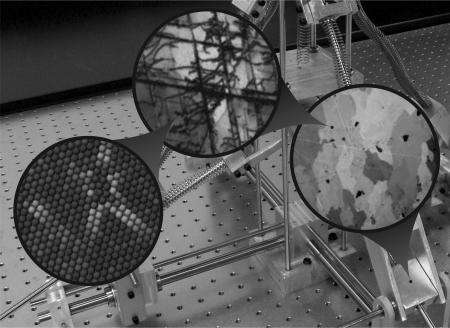Everyone starts small: How metals learn to behave

On Wednesday, February 12, Assistant Professor of Aerospace Dennis Kochmann will explain how controlling a material's complex structural details from the atomic scale up can affect its behavior in everyday life.
The talk begins at 8:00 p.m. in Caltech's Beckman Auditorium. Admission is free.
Q: What do you do?
A: We study the mechanics of materials. Specifically, we're making computer models that start with collections of individual atoms, and we're trying to extend those models all the way up to the scale of visible objects. We also have a lab where we make new materials and test them to see if they behave the way the models predicted. And eventually, once we have that understanding, we'll try to go back downward—if we want a material with certain properties, how do we make it?
Most innovation nowadays depends on new materials. In energy, in space travel, in biomedicine, many of the challenges involve finding a material that can meet certain conditions or that we can use in an extreme environment. It used to be that whenever you needed a specific material, you would tell your colleagues, "I want a material that has this and this and this property," and they'd look in various handbooks and try to find something that met your conditions. Nowadays we do it online, but it's basically the same process. In the future, we want to be able to tell our computer, "Okay, I want this and this and this," push a button, and an hour later the material is delivered to you. We're far away from this, of course.
It's much more complicated than just looking at the periodic table and throwing atoms together. Getting something on the atomic level is just one challenge. We also need to bridge the scales from atoms to the visible, macroscopic scale that we can see with the naked eye. There are many, many levels in between. Atoms form crystals. The crystals have defects. The defects arrange into networks. So if you put any material under a microscope, as you zoom in closer and closer you'll find that on each level there's a very specific pattern. These very specific structures and the things going on at each level are what give the material its unique properties.
Q: What gets you excited about this?
A: Well, as any researcher would say, it's doing something nobody has ever done before. In our case, making new, peculiar materials, or materials with extreme properties.
For example, we are designing materials that are pretty boring under ambient conditions, but if you tweak the temperature or the electric field the material suddenly gets 100 times stiffer and 100 times better at damping out vibrations. So you can control these properties with the push of a button. Usually, stiffness and damping are mutually exclusive. On the atomic scale, if you want something stiff and strong you need a perfect crystal. If you want high damping, there must be mechanisms at the microscale such as crystal defects that somehow absorb energy. Materials that do both are of great interest in applications such as aerospace—airplanes and spacecraft need materials that can withstand extreme conditions while absorbing vibrations, because there's a lot of vibration going on in them.
Q: How did you get into this line of work?
A: Before I went to college, this was absolutely not my goal. I started playing classical music on the organ when I was a teenager, and so I was trying to decide between music and chemistry. Then someone told me that engineering was a safer career, so I ended up in majoring in mechanical engineering. I wanted to be a design engineer, but by coincidence I was offered a job in solid mechanics, which is the mechanics of materials. By yet another coincidence I ended up at the University of Wisconsin–Madison, where I worked with Roderic Lakes and Walter Drugan—pioneers in the design of extreme materials. So as is often in life, it was many small events and little coincidences.
Q: Do you still play the organ?
A: I do. I'm very lucky. There's a church up in Altadena that lets me go up there every Friday morning for two hours and practice.
Q: Do you plan on giving a recital any time soon?
A: [laughs] No.



















